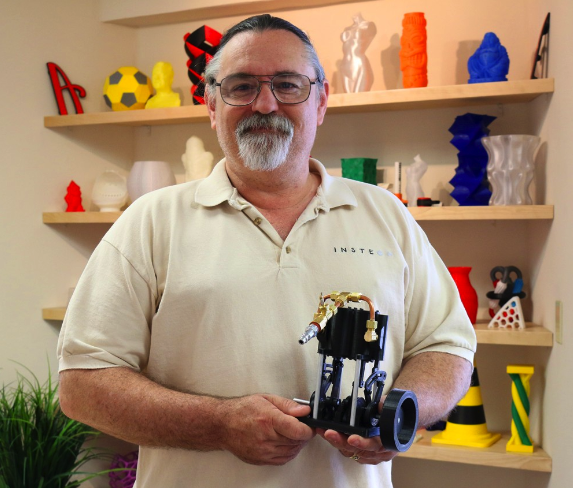Results 1 to 10 of 14
-
07-03-2015, 08:24 AM #1
Engineer 3D Prints Entire Working Engine -- A Locomotive is Next
Airwolf 3D has a loyal customer following, built on the company's reputation for high-quality 3D printers. Geoffrey Shulz, one of these loyal customers, is looking to a retirement filled with more time for 3D printing projects, and lately brought his creative drive together with his love for locomotives. He has designed and created a 3D printed steam engine, initially to teach his son how steam engines function, but also to eventually power a fully 3D printed locomotive. The engine can run off just 5 psi of air pressure and includes as Stephenson valve that allows it to run in reverse. Find out more about the engine project here: http://3dprint.com/78584/3d-printed-engine-2/
Below is a photo of Shulz with his engine:

-
07-03-2015, 10:20 AM #2
Not the engine you think. Its not an internal combustion engine nor is it what appears to be a steam engine. From everything shown, its being run off compressed air. Its simply a compressed air reciprocating device. Not that that isn't an achievement itself.
But I would love to see what happens if he really fed it from a steam boiler. I would bet it would warp beyond function in very short order. The melting point of ABS is around 105c. Steam starts at 100c (212F) and goes up from there when it becomes super-heated steam. There is a mere 5C margin of error here before the steam can actually melt ABS parts. I suspect warping will occur at far less than 105c.
It doesn't say what he printed it from, looks like ABS. Doesn't look like any high temp stuff like Nylon.
Most of the time if it walks like a duck and quacks like a duck, its a duck. This time I think its a chicken.
-
07-24-2015, 12:41 PM #3Student

- Join Date
- Jul 2015
- Posts
- 5
You totally missed the point in this project. This was intended to be a fit-check of the parts before machining out of metal. Further, it was used as an educational aid to show my son how steam engines work and how they can be reversed. This was never expected to be a practical "Steam" driven engine. The fact that it runs on compressed air doesn't make it less of a "Steam" engine. If you are going to play word games, you can discuss it with the dozens of 3D printed "Steam" engines shown on YouTube. Have you printed a working "Steam" engine? For an "Engineer-In-Training", you should show more respect to those of us that have been doing this for a long time, even though my expertise is as a EE not a ME. As an engineer, I hope you pay closer attention to the details of your projects than this. I would say it's sour grapes, but I think it's just chicken.
-
07-24-2015, 01:35 PM #4Staff Engineer

- Join Date
- Dec 2013
- Location
- Georgia
- Posts
- 934
To be fair, the blurb never mentioned that it was a test-fit project, and it's been more rare that people actually go to read the full article. (who can blame them with the clickbait ads at the bottom becoming full-on NSFW lately)
Also, the "Engineer in Training" title is just an internal forum title based on the number of posts, I'm pretty sure Wolfie hasn't taken the FE. (No offence meant, of course)
It would be very cool to print this in PTFE and run it with steam though.
-
07-24-2015, 03:57 PM #5Student

- Join Date
- Jul 2015
- Posts
- 5
I agree! It has been quite an education learning how to work with ABS. I am looking forward to learning new materials. It certainly seems plausible that it would work on steam.
To clarify some details, I never said I would 3D print a complete locomotive (writers licenses I guess), but intended to fit check as many parts as are practical before committing to machining.
-
07-24-2015, 07:24 PM #6Banned

- Join Date
- Jan 2015
- Posts
- 306
Get a metal SLS printer so that you have a ready engine on the first manufacturing process!! 3D print to replace all processes!! The time is NOW!
-
07-24-2015, 10:34 PM #7Student

- Join Date
- Jul 2015
- Posts
- 5
That would be cool. I saw this article showing basically the same components as a typical Reprap, but using a modified Tig welder:
http://hackaday.com/2013/12/07/a-ros...ng-3d-printer/
-
01-05-2016, 01:03 PM #8Student

- Join Date
- Jan 2016
- Posts
- 3
It looks like you made the cylinder "block" in 2 pieces, how hard were they to align? Would you be willing to share your stl files?
thanks,
Matt
-
01-05-2016, 03:38 PM #9Student

- Join Date
- Jul 2015
- Posts
- 5
Hi Matt,
The cylinder block was printed in one piece (not counting the caps). I attached a zip of the files. Sorry it is so disorganized. I designed it in FreeCAD, so you can open the design file in that to see the assembly. The aluminum rod used for the crank shaft and vertical supports is 1/4", available at any hardware store. I believe the screws for the caps were 4-40 and the rest were 6-32. I'll be happy to answer any questions you have.
Geoffrey Schulz
-
01-05-2016, 03:45 PM #10Student

- Join Date
- Jan 2016
- Posts
- 3






 Reply With Quote
Reply With Quote






Ender 3v2 poor printing quality
10-28-2024, 09:08 AM in Tips, Tricks and Tech Help